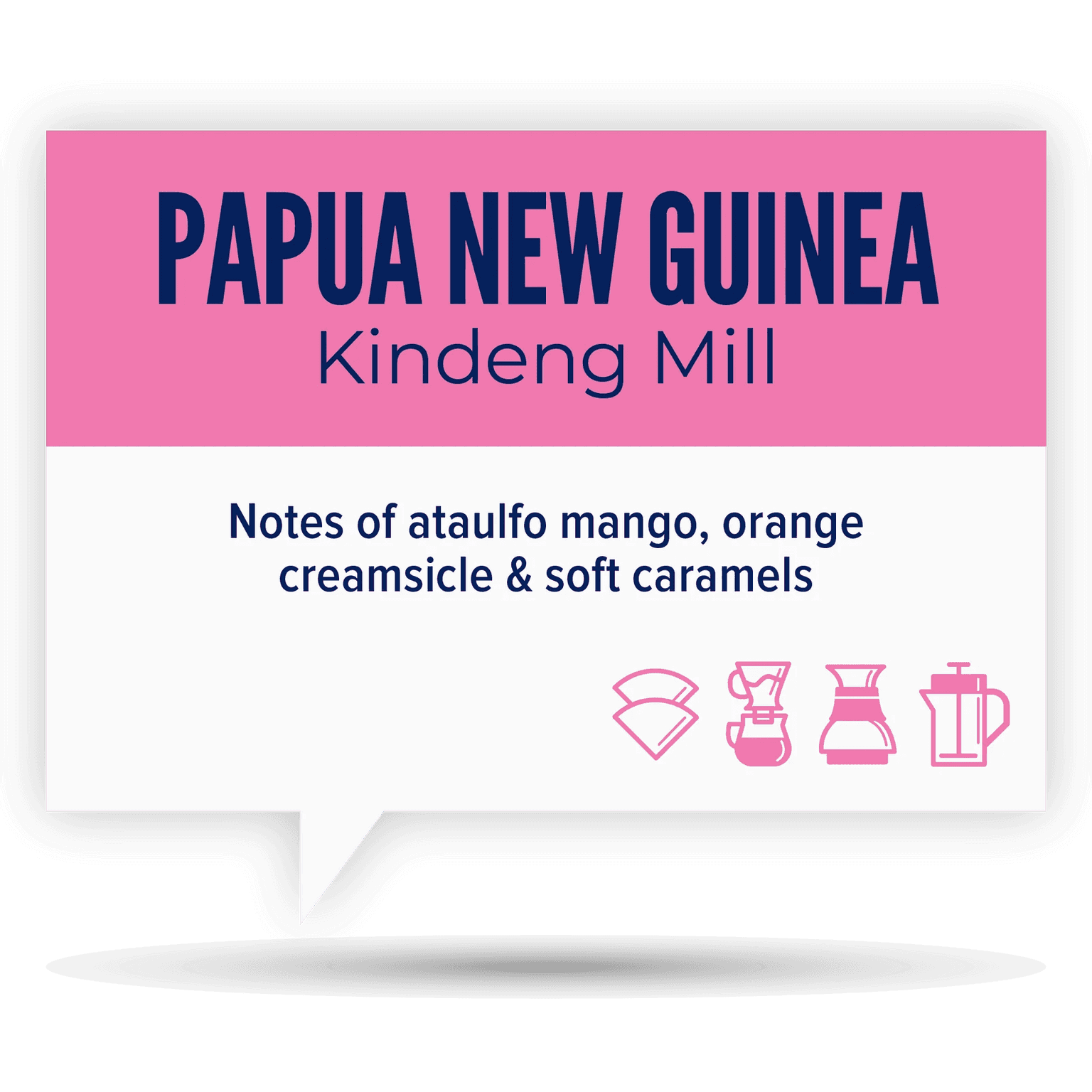Th3rdwave Directories
Cafés
Roasters
Coffees
Guides
Awards
Th3rdwave Coffee Club
Subscription
Gift subscription
Current edition
Past editions
Shop
Advent Calendar
Coffee games
Th3rdwave Wallet
Loyalty cards
Gift cards
Th3rdwave for cafés
Th3rdwave for roasters
Get free coffee
Kindeng Mill
The Wahgi Valley is situated in the central highlands of Papua New Guinea. This valley is part of the larger Western Highlands Province and is characterized by its mountainous terrain, lush landscapes, and fertile soils. The Wahgi River flows through the valley, contributing to its agricultural richness. The region is known for its diverse traditional cultures and vibrant communities, with people engaged in agriculture as the primary livelihood, cultivating crops such as sweet potatoes, coffee, and vegetables.
This coffee comes from the Kindeng Dry Mill in Wahgi Valley. The mill receives cherries from 1500 farmers in the area. The average farm size of producers in this area is about 1–2 hectares, and the soil is generally sandy loam and loamy clay. After cherries are received at the mill, they are processed accordingly and dried on raised beds and canvasses. They are moved multiple times a day throughout the average 30-day drying process to ensure an even and uniform average moisture content across the lot. Once the coffee is adequately dried, it is placed into bags, stored in a cool and dry warehouse, hulled, milled, and prepped for export.
The resulting cup reminds us of mango, orange creamsicle and caramel.
This coffee comes from the Kindeng Dry Mill in Wahgi Valley. The mill receives cherries from 1500 farmers in the area. The average farm size of producers in this area is about 1–2 hectares, and the soil is generally sandy loam and loamy clay. After cherries are received at the mill, they are processed accordingly and dried on raised beds and canvasses. They are moved multiple times a day throughout the average 30-day drying process to ensure an even and uniform average moisture content across the lot. Once the coffee is adequately dried, it is placed into bags, stored in a cool and dry warehouse, hulled, milled, and prepped for export.
The resulting cup reminds us of mango, orange creamsicle and caramel.
The Wahgi Valley is situated in the central highlands of Papua New Guinea. This valley is part of the larger Western Highlands Province and is characterized by its mountainous terrain, lush landscapes, and fertile soils. The Wahgi River flows through the valley, contributing to its agricultural richness. The region is known for its diverse traditional cultures and vibrant communities, with people engaged in agriculture as the primary livelihood, cultivating crops such as sweet potatoes, coffee, and vegetables.
This coffee comes from the Kindeng Dry Mill in Wahgi Valley. The mill receives cherries from 1500 farmers in the area. The average farm size of producers in this area is about 1–2 hectares, and the soil is generally sandy loam and loamy clay. After cherries are received at the mill, they are processed accordingly and dried on raised beds and canvasses. They are moved multiple times a day throughout the average 30-day drying process to ensure an even and uniform average moisture content across the lot. Once the coffee is adequately dried, it is placed into bags, stored in a cool and dry warehouse, hulled, milled, and prepped for export.
The resulting cup reminds us of mango, orange creamsicle and caramel.
This coffee comes from the Kindeng Dry Mill in Wahgi Valley. The mill receives cherries from 1500 farmers in the area. The average farm size of producers in this area is about 1–2 hectares, and the soil is generally sandy loam and loamy clay. After cherries are received at the mill, they are processed accordingly and dried on raised beds and canvasses. They are moved multiple times a day throughout the average 30-day drying process to ensure an even and uniform average moisture content across the lot. Once the coffee is adequately dried, it is placed into bags, stored in a cool and dry warehouse, hulled, milled, and prepped for export.
The resulting cup reminds us of mango, orange creamsicle and caramel.
Coffee origin
Country
Papua New Guinea
Region
Wahgi Valley
Variety
arusha, bourbon, typica
Altitude
1520 - 1770 m
Farm
1500 farmers
Producer
Kindeng Dry Mill
Roast level
Light
Process
natural
Tastes like
🥭
mango
🍦
orange creamsicle
🍮
caramel
Community reviews
😃
4.3 Outstanding
6 Reviews
Show all reviews
What people are saying
Recipes

Chemex by Spectrum Coffee
Chemex

Aeropress by Sorellina
AeroPress

Hario V60 by Ritual Coffee Roasters
Pour over
Check out more in the App








